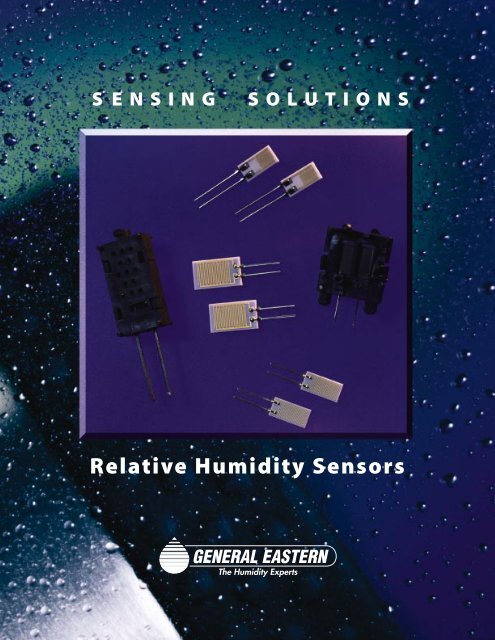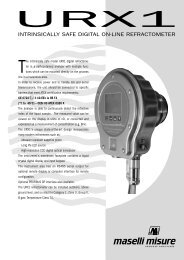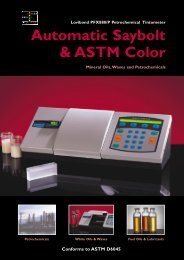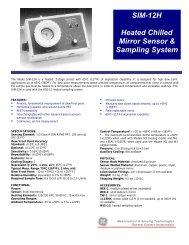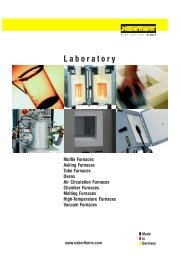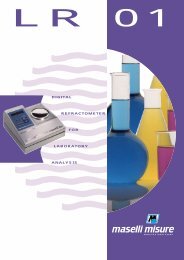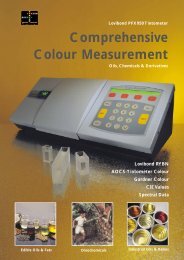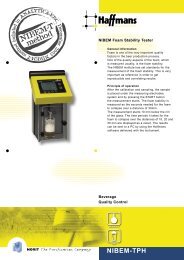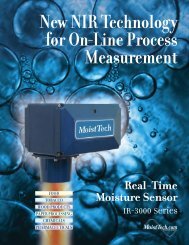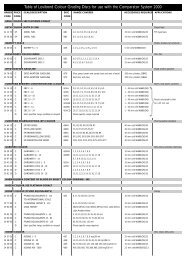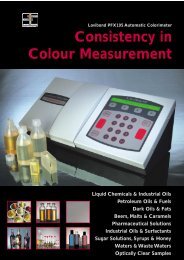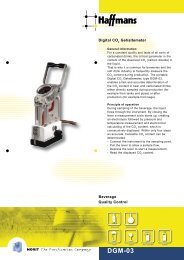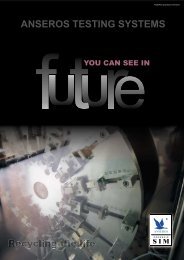Sensor Brochure - PDF2
Sensor Brochure - PDF2
Sensor Brochure - PDF2
Create successful ePaper yourself
Turn your PDF publications into a flip-book with our unique Google optimized e-Paper software.
SENSING<br />
SOLUTIONS<br />
Relative Humidity <strong>Sensor</strong>s
More Than <strong>Sensor</strong>s...<br />
Sensible Solutions<br />
When you need the perfect relative humidity sensor for your product,<br />
you’re interested in the results: Will it work accurately? Will the sensor last in your<br />
particular application? Is it cost-effective? Is it available in the quantities you need?<br />
You don’t want to hear why a single sensor is the ONLY one for your application. In<br />
fact, no single relative humidity sensor is ideal for every application.<br />
General Eastern Instruments offers the greatest diversity of humidity<br />
sensing technologies available. Choose from two capacitive relative humidity<br />
sensors and three resistive relative humidity sensors. With no stake in promoting a<br />
particular sensor or humidity sensing technology, you’ll get the correct solution,<br />
and the right sensor, for your particular need.<br />
General Eastern can help you integrate these components into your<br />
circuits. We can also provide calibrated electronics to shorten your<br />
development cycles or we can help you develop your own calibration<br />
process to assure your product’s quality.<br />
Resistive <strong>Sensor</strong>s —<br />
Proven Technology for Tough,<br />
Condensing Environments<br />
Resistive humidity sensors work by using a moisture-sensitive material on an<br />
interdigitated electrode substrate. The device’s resistance varies exponentially with variations in<br />
relative humidity. The main advantage of resistive technology for humidity sensors is that it is<br />
suited for use in varying, difficult, condensing environments.<br />
Capacitive <strong>Sensor</strong>s —<br />
The Solution for Aggressive Environments<br />
Capacitive humidity sensors utilize conductive plates formed on a dielectric film.<br />
This forms a capacitor that is sensitive to the amount of water vapor in the air. The active<br />
portion of the sensor changes its dielectric constant as it absorbs atmospheric humidity, which<br />
varies the sensor’s capacitance in proportion to changes in relative humidity. One benefit of<br />
capacitive sensor technology is that it’s suited for use in chemically aggressive environments<br />
like the chlorinated air around swimming pools and the ammonia present in the air of many<br />
livestock facilities.
A Summary of <strong>Sensor</strong>s...<br />
Which Is Right for␣ You?<br />
HUMIDITY SENSOR SELECTION SUMMARY<br />
Principle Capacitive Capacitive Resistive Resistive Resistive<br />
G-CAP 2 APS - 200 RH - 8 EMD - 2000 EMD - 3000<br />
Best RH Range 3 to 95% 3 to 95% 20 to 100% 20 to 100% 20 to 100%<br />
Linearity ±2% ±2% Logarithmic Logarithmic Logarithmic<br />
Response Speed<br />
(63% Step)<br />
45 Sec Max 90 Sec Max 120 Sec Max 15 Sec Max 15 Sec Max<br />
Hysterisis < 2% < 2% < 3% < 5% < 1%<br />
Water Immersion No Drift < 2% Drift < 5% Drift Not Acceptable < 3% Drift<br />
Condensation<br />
Effect<br />
Temperature<br />
Effect<br />
No Drift < 2% Drift < 3% Drift < 3% Drift < 3% Drift<br />
0.1% RH/ o C 0.2% RH/ o C 0.3% RH/ o C 0.3% RH/ o C 0.3% RH/ o C<br />
Stability 0.5% RH/Year 0.5% RH/Year < 1% RH/Year < 1% RH/Year < 1% RH/Year<br />
<strong>Sensor</strong> Accuracy ±3% RH Uncalibrated ±5% RH ±1,2,3,5% RH ±1,2,3,5% RH<br />
Chemical<br />
Resistance<br />
Good Excellent Good Excellent Excellent<br />
= Highly Suited<br />
= Works in this Situation<br />
= Not Optimal Properties
The Phys-Chem EMD Series<br />
Resistive Relative Humidity <strong>Sensor</strong>s<br />
General Eastern purchased Phys-Chem Scientific Corp. for their high quality resistive sensor. Now General Eastern<br />
manufactures those same high quality sensors in our own facility. First, there was the EMD-2000 sensor, known for its tight<br />
accuracy and strong resistance to chemicals. Now, the EMD-2000 is joined by the EMD-3000, which offers not only high<br />
accuracy but also improved hysteresis and a compact size. Both sensors are bulk polymer RH sensors that change resistance<br />
as the relative humidity changes.<br />
EMD-2000 and 3000 Relative Humidity <strong>Sensor</strong>s are ideal for humidity measurement<br />
applications that require a high degree of accuracy without calibration. The EMD-3000 offers low<br />
hysteresis (
The G-CAP2 <br />
Capacitive Relative Humidity <strong>Sensor</strong><br />
With a polymer capacitive sensor that varies as little as 3% RH, the G-CAP2 offers exceptional<br />
interchangeability, so you spend less time on assembly and production calibration. By contrast, some<br />
competing capacitive sensors vary by as much as 40% or more. Such wide variances require time-consuming<br />
calibration that affects manufacturing costs and cycle time.<br />
For customers with calibration capabilities, an economical, uncalibrated version of the G-CAP2 is<br />
offered in various capacitance ranges. Otherwise, the G-CAP2 comes factory-calibrated to within ±1 picofarad<br />
(pf), for relative humidity measurement accuracy of ±3% RH. Drift is under 1% per year and declines<br />
logarithmically, compared to the industry average of 3% per year for some capacitive sensors.<br />
The G-CAP2 can function in 100% humidity and its wide measurement range can handle most<br />
applications. It is ideally suited for high volume applications, where it reduces the time required for final<br />
assembly and calibration. The simple, low-cost circuitry required for the G-CAP2 sensor can also produce<br />
cost savings.<br />
General Eastern’s <strong>Sensor</strong> Evaluation Kit is available with the G-CAP2 sensor. The kit includes five G-CAP2 sensors and<br />
a PC board with a 0-5 volt output. The PC board features plug-in connectors that allow engineers to evaluate each G-CAP2<br />
sensor without the need to design special test circuits. The Evaluation Kit includes full documentation, along with instructions on<br />
how to devise some simple tests.<br />
Typical <strong>Sensor</strong> Characteristics<br />
(Calibrated version only)<br />
Evaluation Kit<br />
% RH Capacitance (pf)<br />
0 148.0<br />
20 156.5<br />
30 159.6<br />
40 162.8<br />
50 165.7<br />
60 168.7<br />
70 171.7<br />
80 174.7<br />
90 178.0<br />
G-CAP2 Properties<br />
Operating Range/Humidity<br />
/Temperature<br />
Capacitance Range<br />
1VRMS (calibrated version only)<br />
Frequency Range<br />
Temperature Effect<br />
Hysteresis<br />
Long Term Stability<br />
<strong>Sensor</strong> Interchangeability<br />
Time Response<br />
MECHANICAL<br />
Assembly<br />
Lead Strength<br />
MATERIAL<br />
Case<br />
Pins<br />
POWER<br />
Maximum Voltage<br />
0% to 100% RH (condensing)<br />
-40˚F to +185˚F (-40˚ to +85˚C)<br />
148pf ± 1pf @ 77˚F (25˚C), 0% RH, 10 KHz,<br />
D.C. to 1MHz<br />
Less than 0.05% RH/˚F<br />
Less than 2% RH @ 25˚C (25% to 80% RH)<br />
Less than 0.5% drift per year typical<br />
Better than ±3% RH (calibrated version only)<br />
30 sec. typical, 45 sec. max., 63% change for<br />
25-75% step change, 150 LFM air flow<br />
<strong>Sensor</strong> can be soldered onto PCB<br />
2 lb. pull test with no damage<br />
PBT plastic, 15% glass fill<br />
Copper with .00001”␣ min. tin plate<br />
5 Volts (across sensor leads), 1 VRMS recommended<br />
Vertical Mount<br />
*Lead reforming by the user may cause sensor failure.<br />
Side Mount<br />
*Dimensions are in inches.
The APS-200<br />
Capacitative Relative Humidity <strong>Sensor</strong><br />
The APS-200 <strong>Sensor</strong> is unique among polymer sensors. Virtually every other capacitive<br />
sensor is composed of a humidity sensitive dielectric material with metal electrodes. The APS-200<br />
is manufactured from a unique, humidity sensing polymer film and the conductor plates of the<br />
capacitor are composed of a conductive, humidity-permeable polymeric film. No metal electrodes<br />
are used in the APS-200. The APS-200’s unique design makes it especially resistant to aggressive<br />
chemical environments, including chlorine and ammonia. Swimming pool areas, in particular,<br />
feature chlorine-laden air that normally attacks sensors with metal electrodes. The APS-200 is ideal for<br />
use in such environments. An additional advantage of the APS-200 sensor is that it is virtually free of drift.<br />
Even after one week’s exposure to temperatures of 85˚C and 85% RH, the tested sensor drifted only 6%. In a test in which it was<br />
exposed to 110˚C temperatures and 5% RH, it drifted a mere 3%. In both of these cases, the sensor also returned to nominal<br />
values after exposure to room temperature air and humidity.<br />
The APS-200 sensor also offers a very wide operating range of -20˚F to +140˚F (-29˚C to +60˚C) and 0-100% RH. Like<br />
the G-CAP2 sensor, the APS-200 sensor is available in an uncalibrated version for customers with calibration capabilities.<br />
Chemical Testing Data @ 50% RH and 25˚C<br />
Chemicals Swimming Pool TSQ Germicide Ammonia 100% Formaldehyde *Mixed Solvents<br />
Environments<br />
%RH Change < 1% < 2% < 5% < 0.5% < 1.5%<br />
* Solvent Mix = acetone, pentane, xylene<br />
APS-200 Properties<br />
Operating Range/Humidity<br />
0% to 100% RH<br />
235<br />
/Temperature<br />
-20˚F to +140˚F (-29˚ to +60˚C)<br />
230<br />
Nominal Capacitance Range<br />
Frequency Range<br />
218pf ± 22pf @ 50% RH<br />
77˚F (25˚C) and 10 kHz<br />
D.C. to 1MHz<br />
Capacitance (pf)<br />
225<br />
220<br />
215<br />
210<br />
ESR (ohms)<br />
Typical Resistance Range<br />
@ 20 to 90% RH, resistance is 5MW to 2.9 kW<br />
205<br />
Temperature Coefficient<br />
Hysteresis<br />
0.12% RH/˚F or .22% RH/˚C<br />
Less than 3% RH @ 25˚C (40% to 80%RH)<br />
200<br />
0 10 20 30 40 50 60 70 80 90 100<br />
Relative Humidity (%)<br />
Long Term Stability<br />
Less than 0.5% drift per year typical<br />
Time Response<br />
90 seconds typical - 63% change for 20-80% RH<br />
POWER<br />
Maximum Voltage<br />
5 Volts (1 Volt, 10KHz recommended)
The RH-8 Bulk Polymer<br />
Resistive Relative Humidity <strong>Sensor</strong><br />
The RH-8 sensor was developed specifically to meet the growing needs of HVAC and other high<br />
volume OEM applications. The RH-8 sensor is also frequently used in protected outside environments. The<br />
sensor works by using an element composed of an electrode base-plate coated with a humidity sensitive<br />
macro-polymer. Changes in relative humidity affect the resistance of the electrode. Small and lightweight,<br />
the RH-8 offers a response of less than two minutes at room temperature. Hysteresis is low, at
The Right Solution for Your Application<br />
General Eastern has over a quarter century of experience in the design,<br />
development, and production of global humidity sensing technologies, relative humidity<br />
sensors, transmitters, generators, and calibration equipment. The company provides<br />
standard and custom-designed humidity measurement solutions for countless applications<br />
over a wide range of industries. Whether your humidity-sensing needs entail choosing the<br />
correct sensing technology, the right sensor, or accurate advice, trust the humidity experts.<br />
The General Eastern Family of Humidity Measurement Products<br />
• <strong>Sensor</strong>s<br />
• Process Humidity Transmitters<br />
• Humidity Transmitters<br />
• Industrial Humidity Transmitters<br />
• Humidity Transfer Standards<br />
• Humidity Generators<br />
Call Today: 800/225-3208.<br />
General Eastern Instruments<br />
20 Commerce Way<br />
Woburn, MA 01801<br />
Ph: 1-800-225-3208 781/938-7070<br />
Fx: 781/938-1071<br />
Website: www.geinet.com<br />
A40199176/A.00


